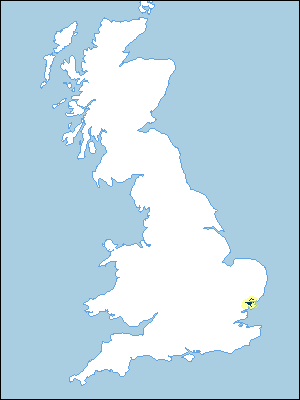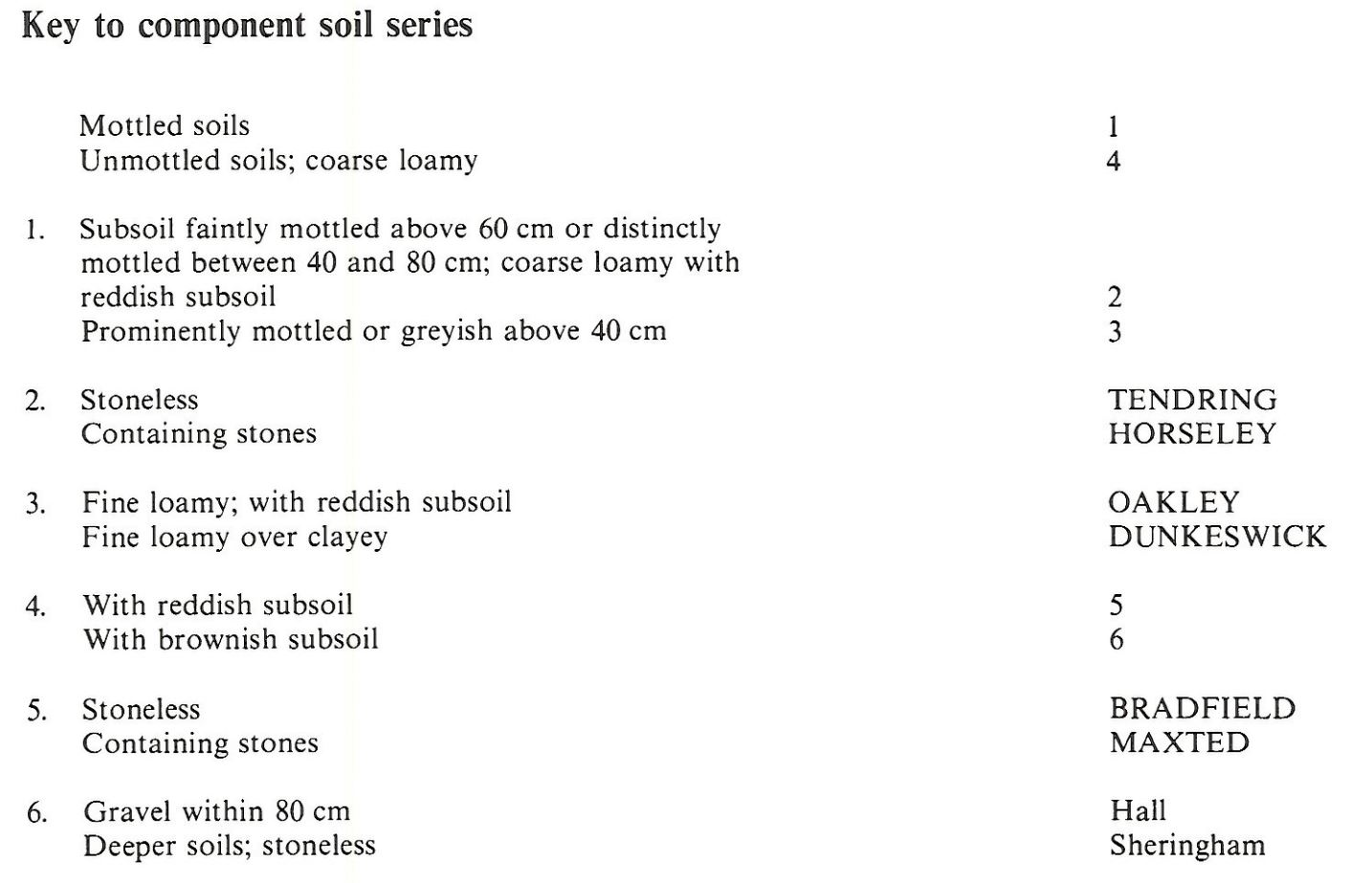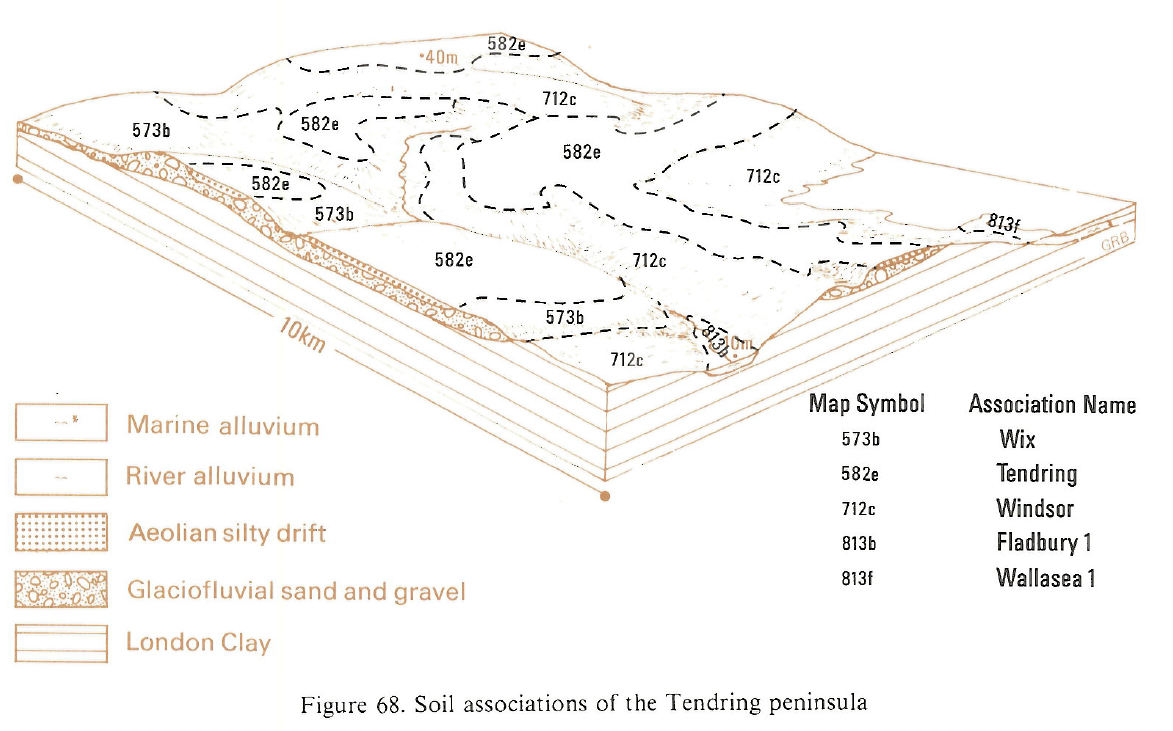
Soil Associations
0582e TENDRING
Soil and site characteristics
Deep often stoneless coarse loamy soils. Some slowly permeable seasonally waterlogged coarse and fine loamy over clayey soils. Patterned ground locally.
Geology
Aeolian and glaciofluvial drift
Cropping and Land Use
Cereals, sugar beet and potatoes some horticultural crops with top fruit.
Component soil series
| Subgroup | Series name | Percentage | WRB 2006 link |
|---|---|---|---|
| 5.82 | TENDRING | 37% | Chromic Endostagnic Luvisols |
| 5.81 | MAXTED | 20% | Ruptic Chromic Luvisols |
| 5.81 | BRADFIELD | 10% | Ruptic Chromic Luvisols |
| 7.14 | OAKLEY | 10% | Albic Luvic Stagnosols |
| 7.11 | DUNKESWICK | 10% | Eutric Albic Luvic Stagnosols |
| 5.82 | HORSELEY | 5% | Chromic Endostagnic Luvisols |
Covers 160 km2 in England and Wales
Soilscapes Classification
| 8 |
Slightly acid loamy and clayey soils with impeded drainage |
0582e TENDRING
Detailed Description
This association consists principally of soils developed in aeolian silty and fine sandy drift over older, coarser textured, glaciofluvial deposits. it occupies level and gently sloping land on dissected plateaux between 25 and 50 m O.D. in north-east Essex and south Suffolk, districts with large summer moisture deficits where these generally water retentive soils are noticeably more productive than adjacent sandier soils.
The superficial windblown drift is usually thick enough to give deep stoneless coarse loamy Tendring and Bradfield soils, stagnogleyic and typical paleo-argillic brown earths respectively; their stony equivalents, Horseley and Maxted series, occur where the aeolian drift is thinner or absent. The glaciofluvial deposits are locally less permeable and carry Oakley series, paleo-argillic stagnogley soils, on fine loamy drift incorporating some Crag. There are also Dunkeswick soils, typical stagnogleys, on fine loamy over clayey drift, formerly described as Weeley series by Sturdy and Allen (1981). There are minor inclusions of Sheringham, Hall, Wix and Quorndon serie. Brief descriptions of Tendring, Bradfield, Oakley and Horseley series are given below. Maxted and Dunkeswick series are described elsewhere in the text.
The association is found on nearly level ground north and south of the Stour. Tendring and Horseley soils together cover about half of the land, with Maxted and Bradfield soils on low ridges or near plateaux margins where natural drainage is better. Oakley and Dunkeswick soils occur mainly in Essex where each covers about one-tenth of the ground. Wix and Quorndon soils are also most common there. North of the Stour around Chelmondiston and Woolverstone, the proportion of Tendring soils is small. Here Maxted and Bradfield series cover about half of the land, and other well drained soils including Sheringham and Hall series most of the remainder. The underlying glaciofluvial deposits have been strongly disturbed and contorted by periglacial processes. Polygonally patterned ground shown by differential crop growth is seen mainly at the plateaux margins where the aeolian drift thins.
Soil Water Regime
Bradfield and Maxted soils are permeable and well drained (Wetness Class I). Since most of the land has been improved by drainage measures, Tendring and Horseley soils are also mainly well drained (Wetness Class I). Exceptionally, where older drainage systems have ceased to function or the deep subsoil is locally more clayey, these soils are occasionally waterlogged (Wetness Class II). Oakley and Dunkeswick soils have slowly permeable subsoils and are also occasionally waterlogged where drained. There are, however, large year-to-year differences in waterlogging, related to rainfall and the length of the meteorological field capacity period. The soils readily accept winter rainfall and there is little surface run-off. All except Dunkeswick soils are slightly droughty for winter cereals and sugar beet but moderately droughty for the shallow rooting potato crop, and very droughty for grass. Irrigation is needed in most years particularly for early and maincrop potatoes and green beans.
Cropping and Land Use
Tendring, Bradfield and Maxted soils are easily worked and there is ample opportunity even in a wet autumn to prepare the ground for winter cereals. Oakley and Dunkeswick soils have a slightly shorter autumn working period, but this limitation is insufficient to affect the pattern of cropping. There are usually enough suitable days for spring tillage so root and vegetable crops can be drilled under good conditions in most years but there are restrictions in wet years. The soils are not suited to the direct drilling of autumn-sown cereals because the topsoils have a large fine sand and silt content and they readily slake and pans are easily formed, leading to restricted rooting and loss of yield. The potential yield of grassland is small unless it is irrigated, but, except on Dunkeswick soils, risk of poaching is negligible. The land is intensively farmed, and is nearly all arable with little grassland. There is some top fruit, mainly apples, and some soft fruit. Winter wheat and barley for malting are the main cereal crops, together with oilseed rape, sugar beet, second early and maincrop potatoes, peas and maize. Some farms specialize in the production of onions, green beans for processing and the growing of other vegetables for the general market. The soils are naturally acid and require periodic liming. In general there are large amounts of phosphorus available to plants, but little potassium and manganese. Boron is required for sensitive crops like sugar beet.
0582e TENDRING
Distribution Map
 |
Note that the yellow shading represents a buffer to highlight the location of very small areas of the association.
Keys to component soil series
Eastern Region
 |
Typical Landscapes
Eastern Region
 |
All information Copyright, Cranfield University © 2025
Citation: To use information from this web resource in your work, please cite this as follows:
Cranfield University 2025. The Soils Guide. Available: www.landis.org.uk. Cranfield University, UK. Last accessed 04/04/2025
